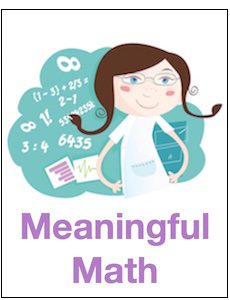Math Ideas to Counter Spring Distractions
A MiddleWeb Blog
 I am on Spring Break this week, which means when we go back to school, we will have eight weeks of learning left. I almost wrote that with a straight face! Realistically, we won’t have anywhere close to 40 days of instruction.
I am on Spring Break this week, which means when we go back to school, we will have eight weeks of learning left. I almost wrote that with a straight face! Realistically, we won’t have anywhere close to 40 days of instruction.
The field trips, school activities (sports, band, chorus, etc.), standardized testing, and benchmarking will either take my students out of the class or interrupt regular instruction.
At times, we will be on a morning schedule, which abbreviates the morning classes while the afternoon classes run as normal – such as on days when we conduct our state testing. Even when we have a “normal” day, many students will be missing from each class for the aforementioned reasons.
This can drive you crazy if you let it bother you. I’ve learned in a decade-plus of teaching that it’s part of the job and I have to try to keep moving forward and not let it stress me out.
So this hectic time of year it’s very important to have several back-up plans. Often, with many of the students away, it is not possible to move into new material. On days my students take their standardized test (in Alabama, it’s ACT for the juniors, Work-Keys for the seniors, and Performance Series for the sophomores) they come to their afternoon classes in a test-induced fog.
On those days, I have a list of tasks, activities, and puzzles prepared for my students so that we can continue to learn. I think middle school teachers find themselves in these same situations, so maybe these strategies will work for you as well.
Beyond those online exercises
I love online apps like Kahoot and Quizlet and so do my students, but I have found that they do eventually get tired of the go-to technology and something done on paper becomes a novelty to them. So the options I am listing here are more of the traditional paper and pencil variety.

What I am talking about here are activities for those extreme days when over half the class is gone or there is a weather day when the students are going to leave at 11:30. In other words, what tends to happen towards the end of the school year.
When I first started teaching, I thought it would be easy to find “fun” activities for my students. Turns out that while I might think something is fun, my students don’t necessarily agree.
Students also tire of an activity fairly quickly so it’s good to have a lot of options in your rotation. I have tried to list the activities and puzzles that I have personally used and found to be successful.
Activities my students enjoy
The first two activities are actually tasks from the MARS (Mathematics Assessment Resource Project). I really like these because they have several entry points for students and they require them to think. Plus, there’s a rubric already made in case you want to grade the activity.
On this site you can find over 40 tasks for middle school students and 52 tasks for high school students. They are all good, but I can personally recommend the two listed here.
1) Matchsticks
Students use the volume of a cone and a prism to figure out how many matchsticks can be made from a single tree. It’s listed as a 6th grade problem, but I would feel comfortable giving it to 10th or 11th graders. (Hint: unit conversion on this one can be tricky.)

Students find the cheapest way to arrange a large and small taxi cab for a group of people. I love this task because there are so many ways to solve this one. According to MARS this is a 7th grade activity, but I think it could work anywhere from 7th grade to my Algebra with Finance (12th graders).
Looking beyond the MARS website . . .
3) 4 Fours
Students use four 4’s and any mathematical operation to come up with the numbers 1-20.
Here’s an example: √4 + √4 + 4⁄4 =
I’ve also used it at the beginning of the year and even students who don’t normally like to participate liked this activity. This is my students’ favorite from Jo Boaler’s website, Youcubed, which includes some other great resources for Spring volatility.
4) SKUNK
On days when my students are really struggling and need to stand up I’ve found they enjoy playing “SKUNK” (it’s also called Greed and a lot of other things). The premise is simple: students stand as two dice are rolled. They can sit at any time. If they are standing when double sixes are rolled, they lose all their points from that round. If they sit before double sixes are rolled, they can keep the points they’ve accrued.

Students really get into the game, and we have risk takers and people who have a strategy or a lucky number, and also those who like to play it safe.
After playing, the students will have accumulated a lot of data, and there are a lot of different ways to use that data. You could divide the class up in some way (gender, grade, etc.) and find the mean, median, mode and range of each group’s score.
SKUNK also opens the door for a good discussion regarding probability. NCTM’s Illuminations has a really good lesson structured around the game, and it explains the rules much better than I can.
What to expect
I hope some of the activities I have shared have been helpful. I would encourage everyone to look at the MAPS tasks because they are very well written and include a variety of different concepts. I always feel like my students benefit from them. One suggestion: if you plan to use a MAPS task in your classroom, work the task ahead of time. Really pushed? Jo Boaler’s website has a variety of activities (sorted by grade, among other categories) that are low prep and engaging.
HELP! I need more activities and tasks in my rotation for when those crazy days happen. I would love to hear what you do during those times when you have to go off your lesson plan. Good luck!




































Hi Michelle. I would love your thoughts on my TEAM UP! math board game, which currently applies to Grades 3-8, but will also have an Algebra and Geometry version sometime in the near future. Twitter: @teamupboardgame . Check out my website at: http://www.commoncoreboardgames.com . And enjoy your Spring Break!
Thanks for letting me know about your board games! I haven’t had a lot of time to look at your website, but from a cursory glance they look really good. Math teachers can use all the resources we can get. Thanks again!
NRICH from the University of Cambridge is our go to source for engaging, really deep, stand alone, low threshold, high ceiling tasks. Tasks are arranged by grade band and also given a difficulty rating. Can be searched by topic, too.
Thank you! NRICH is a great resource! I had looked at it awhile back and had forgotten about it. After you reminded me, I went back and looked at it and immediately found an activity I wanted to do-“Sticky Numbers” you take the numbers 1 to 17 and arrange them so that adjacent numbers add up to a perfect square. I can’t wait! https://nrich.maths.org/6571 Thanks again!!
Michelle, this was great! I’ve been looking for more of the same type of tasks. I was in the situation you described the day before spring break, so I used the following three puzzles. Most students completed the first in about 10-25 minutes. The second was much harder for them; they needed guidance. I literally tell them to “think outside the box”, but they need to think outside the box to use that clue correctly. I would probably do the third challenge second if I were to use these all on the same day again. I have all three laminated so they can use dry erase markers and try and try again.
1. Place ten dots (or xs) in a 4×4 grid such that each row and column has an even (i.e. not odd) number of dots.
2. http://www.archimedes-lab.org/How_to_Solve/9_dots.html
3. A very cold town in Minnesota has 8 main buildings. The townspeople want to build tunnels such that each building is connected to every other building by a tunnel and you can go between any two buildings without passing through another tunnel or building. How many tunnels are necessary? (Answer: 28)
Jess
Bonus: http://mathforum.org/library/drmath/sets/select/dm_1000_lockers.html
Thank you! Those are great ideas!! It’s so important to find that sweet spot where the puzzle is not too easy or too hard, but just challenging enough to keep them interested. The ones you shared seemed like they would be just right. Also, laminating them is a great idea! Thanks again!
KenKen puzzles! My students love them! Free, printable or electronic.